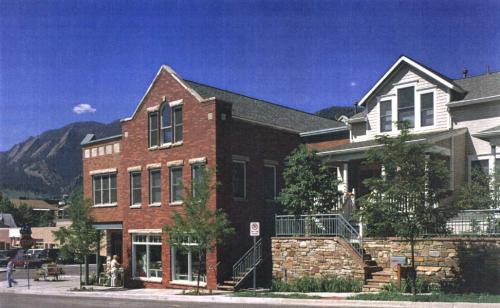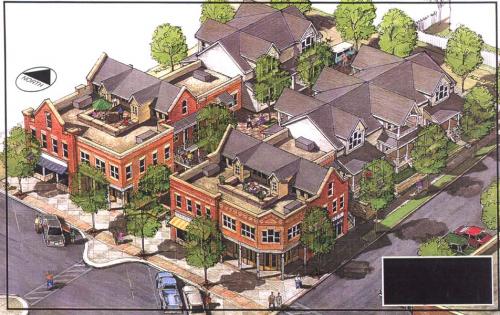
Eighth & Pearl
Location: Boulder, Colorado, United States. Former Gas Station
Working in accordance with the inspiration of the surrounding traditional architectural styles, this project transformed a former gas station site into a dense urban block. The development, adjacent to a historic, zero-setback main street, provides a mixed-use forum for residential units, local businesses, and professional offices. In doing so, Eighth & Pearl contributes to the quality of urban slife in downtown Boulder.
The resulting project is what juror Ray Gindroz calls, “An important prototype.” Mr. Gindroz calls attention to the creative mix of uses in a low-rise structure. “Putting stores on the commercial street and housing in the rear is the way to organize a block in this kind of setting.”
Boulder, Colorado is a city of 100,000 with mass transit and excellent pedestrian and bicycle facilities. Pearl Street, on one side of the site, is the city’s historic main street; several blocks away, the street becomes a pedestrian mall. On the other three corners of the intersection, older buildings front the sidewalks.
Despite the surrounding urban fabric, zoning for the lot was the same as that for the city’s 4-lane commercial strip: setbacks of fifteen to twenty feet, high parking requirements, and no discretionary variances. With sympathetic city planners, Wolff Lyon created a zoning category to allow appropriate setbacks and less parking. It allows floor area ratio (FAR) to be split: 2:3 for commercial uses, with an additional 1:3 permitted for residential space. The total 1:1 FAR is appropriate for the area, generating two- and three-story buildings with moderate on-site parking.
The project at Eighth and Pearl takes advantage of the new zoning, combining retail, office, and residential space above 28 underground parking spaces. The mix of uses creates a safe environment, as the building is in use at all hours. Subtle changes in brick type, color, and architectural details break the building into 25-foot sections, to help the architecture fit in with the historic surroundings. Replacing a gas station, this project creates street edges that define the public realm.
The five residential units are placed over the parking garage and provide a graceful transition from the busy main street to the historic residential district to the north. Each residence has a large front porch with a 7-foot deep dooryard facing the quieter back streets.
Storefronts are placed along the Pearl Street sidewalk, with offices over the shops. The offices bring in the outdoors with rooftop terraces and operable windows. The shops connect to the street through two recessed arcades with large sets of double doors; merchandise is displayed on the sidewalk. The ground floor tenants include a home and garden store, a wine shop, an antique store, and a small bakery cafe. Cafe tables in the arcade and courtyard invite the life of the sidewalk into the more intimate and quiet realm of the courtyard.
The central courtyard, which creates a pedestrian street through the project, is an important organizing element. Second-floor offices and residential back porches open onto the upper courtyard. The courtyard provides improved light and ventilation, promoting natural cooling. The site design promotes walking by providing neighbors with casual opportunities for socializing. Low stone walls and planting areas encourage sitting, lingering, and contemplation.
In the end, the project demonstrates what a strong-willed architect and developer can do with a site. “The architect and developer had a vision” says Juror Jonathan Barnett. “They took risks to make it come to life.”
Transect Zone(s): T6 core, SD district.
Status: <Unknown>
Project or Plan's Scale: Block
Total built area (in sq. ft.):
Total project cost (in local currency):
Retail area (in sq. ft.):
Office area (in sq. ft.):
Industrial area (in sq. ft.):
Number of hotel units:
Number of residential units (include live/work):
Parks & green space (in acres):
Project team designers: Wolff Lyon Architects
Project team developers: John Wolff, Tom Lyon, David O'Neil
Previous site status:
Starting/Ending date of construction/implementation: -



